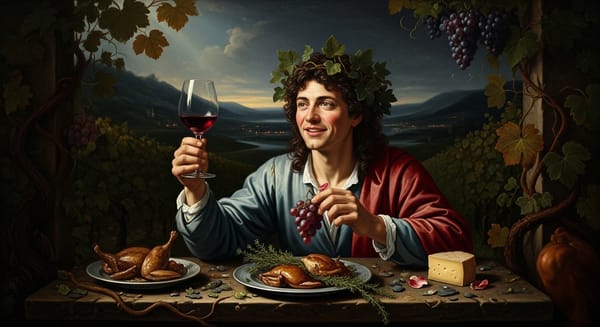Fire in the Hills: Giuseppe Quintarelli Amarone della Valpolicella Classico Riserva 2011
Discover the best Giuseppe Quintarelli Amarone della Valpolicella Classico Riserva 2011 food pairing ideas, from lamb to risotto and aged cheese.

When I pour Quintarelli’s 2011 Amarone della Valpolicella Classico Riserva, the glass itself seems to blush—dense garnet at the core, shading to brick at the rim, a flame banked but not extinguished. Give it time: two full hours in a broad-shouldered decanter at a gentle 17 °C, and the wine unlaces its tight weave. In a tulip-bowled glass, the aromas rise slowly, like incense in a vaulted chapel—black cherries steeped in liqueur, dried rose petals, cocoa dust, and a resinous echo of pine. The texture is velvet stretched taut over iron; the tannin, that gentle drying grip on the cheeks, moves with precision, not aggression.
The Stone Terraces of Negrar
The story of this bottle begins in northern Italy, in Veneto’s Valpolicella Classico zone, on the steep slopes above the town of Negrar. This is the home of Giuseppe Quintarelli’s fabled estate, where hand-painted labels conceal some of the most revered wines of Italy. Quintarelli’s name has become synonymous with patience and fidelity to tradition. The grapes—Corvina, Corvinone, Rondinella, with whispers of other local varieties—are dried for months on straw mats in cool lofts, a practice called appassimento, concentrating sugars and flavors before fermentation. The soils here are marl and volcanic basalt, lending both mineral edge and warmth, while cool nights under mountain air slow the ripening, preserving acidity. The 2011 vintage was warm and generous, yet in these terraces, heat was tempered by breezes from Lake Garda, allowing fruit to ripen with both opulence and lift.
A Voice of Fire and Resin
On the nose, the 2011 shifts with the hours—chocolate-covered figs, sweet tobacco, cinnamon bark, then a lift of balsamic herbs. On the palate, richness unfurls: a swell of dark fruit—plums, cherries, even a flicker of date—yet buoyed by freshness that keeps the wine from collapsing under its own weight. The tannins are polished, almost waxy, carrying the fruit along a long arc toward a finish of cedar and spice. Amarone is always full-bodied, but here the density is sculpted, not bludgeoning. The finish lingers for minutes, each breath carrying another layer, as though the wine refuses to let you turn away. Cellared well, it will evolve into 2035 and beyond, deepening in its earthy bass notes while softening its edges.
Flesh and Flame
With such structure and depth, classic pairings rise to the surface like truths remembered. Roast lamb, studded with rosemary, finds its mirror in Amarone’s herbal lift. The fat of the meat mellows the tannins, while the char on the crust harmonizes with the wine’s cocoa and smoke. Likewise, a braised beef cheek—long-cooked until it collapses in its own jus—draws out the wine’s savory side, each bite refreshed by the acidity threaded through its richness. These are not mere matches; they are conversations, flesh speaking to vine.
Silk and Spice Beyond the Hills
The Amarone’s balance of sweetness and grip also allows it to dance in unexpected arenas. Consider Peking duck, with its lacquered skin and sweet-sour plum sauce: the wine’s dried-cherry depth and gentle bitterness play against the bird’s fat and the sauce’s brightness, creating a layered, almost theatrical duet. Or a Persian lamb stew laced with pomegranate molasses and walnuts: the interplay of fruit, spice, and earthy crunch resonates with Amarone’s own bittersweet symphony.
Soil’s Whisper: Vegetarian Harmonies
Yet the wine’s grandeur is not reserved for meat. Mushroom risotto, glossy with butter and Parmesan, sets its umami against the Amarone’s fruit, the cream smoothing its tannins, the porcini echoing its earthy undertones. Truffle-laced polenta, rich and soft, creates a stage on which the wine’s spice and mineral edge perform. Here, the vine finds kinship not with flesh but with soil, reminding us that both grape and fungus grow from the same dark loam.
Quiet Companions of the Table
Sometimes it is the supporting players that unlock Amarone’s secrets. A slab of aged Asiago, its nutty saltiness amplifying the wine’s sweetness, can be as transporting as any main course. Or pommes Anna, thin potatoes layered in butter, crisp at the edges—each bite a canvas for Amarone’s fruit to paint upon. These smaller offerings reveal how a monumental wine can be tender, how its might can bow toward intimacy.
Myth and Memory Between Sips
As I taste, I remember my own descent each year into the underworld, half my life spent in shadow, half in light. Like Amarone itself—grapes shriveled in death to be reborn in fermentation—I too have known the silence of loss and the joy of return. A goddess of vines must honor such cycles. The wine’s every sip is a reminder that grief and sweetness coexist, that richness can be tempered by grace, that nothing endures without patience.
A Closing Blessing
If you open this 2011, open it with reverence. Let it breathe, let it speak in its own tongue, do not rush. In a broad glass, at the right coolness, with patience, it reveals layers that speak of hillsides, of fire and stone, of a winemaker’s devotion. Share it with lamb or duck, risotto or cheese, but most of all, share it with time. Today, it is vivid and deep; by 2038, it will be an elder, softer in tone but rich in wisdom. May your table be worthy of its story.





